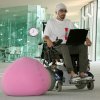Researchers have been perfecting technologies that allow disabled people to control wheelchairs and prosthetic devices by simply focusing their brain on certain tasks. While amazing, this technology can be very tasking on its users, requiring the constant ability to clear the mind and quickly focus on activating the prosthesis. At the Swiss Federal Institute of Technology (EPFL), researchers have been testing shared control systems that combine EEG brain signal monitoring with autonomous prosthesis control to help disabled people manipulate their devices with greater ease.
Specifically, they’ve been testing a wheelchair designed at EPFL that performs many of its low-level functions automatically, relieving the brain from constantly having to focus on the wheelchair. The chair is aware of its location and combines signals received from the brain to help control it in an easy and more natural way. They showed that the wheelchair users were able to operate it for considerably longer periods compared to when the shared control system was turned off.
A further component that will facilitate intuitive and natural control of motor neuroprosthetics is the incorporation of rich multimodal feedback and neural correlates of perceptual processes resulting from this feedback. Realistic sensory feedback must convey artificial tactile and proprioceptive information —i.e. the awareness of the position and movement— of the neuroprosthesis. This type of sensory information has potential to significantly improve the control of the prosthesis by allowing the user to feel the environment in cases in which natural sensory afferents are compromised —either through other senses or by stimulating the body to recover the lost sensation. Furthermore, rich multimodal feedback is essential to promote user’s agency and owernship of the prosthesis. Finally, we can decode and integrate in the prosthetic control loop information about perceptual cognitive processes of the user that are crucial for volitional interaction, such as awareness to errors made by the device, anticipation of critical decision points, and lapses of attention. As in natural motor control, this information can dynamically modulate interaction.
source:Cognitive Neuroscience Society
Shared Control Systems Aid Brain-Computer Interfaces to Control Prostheses

